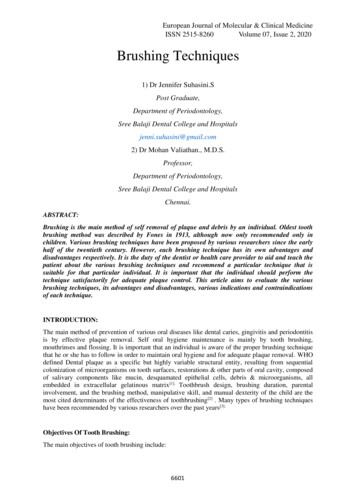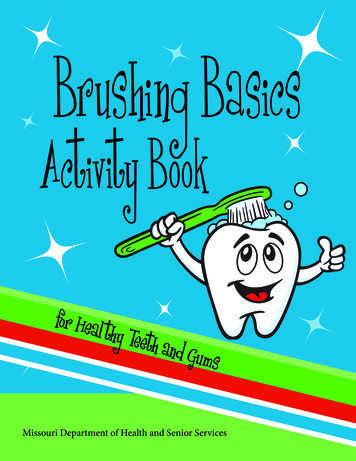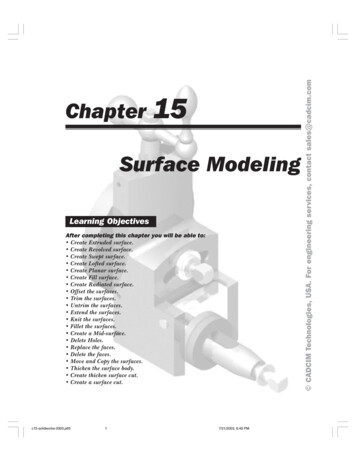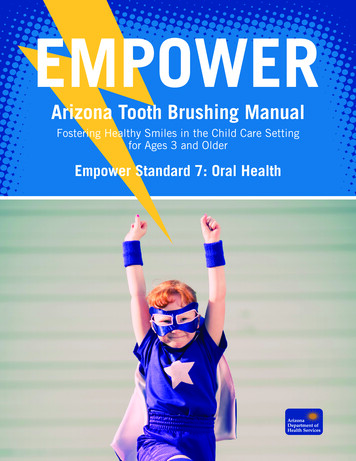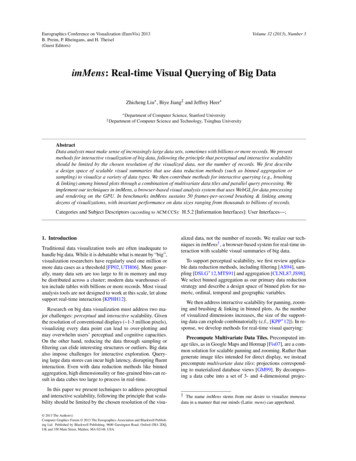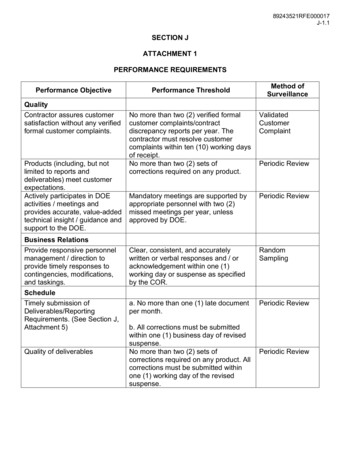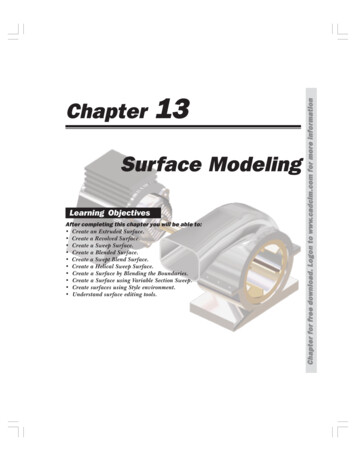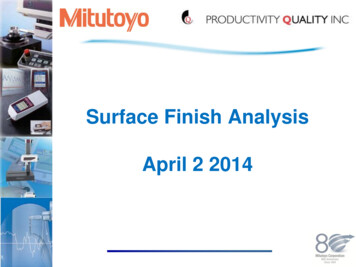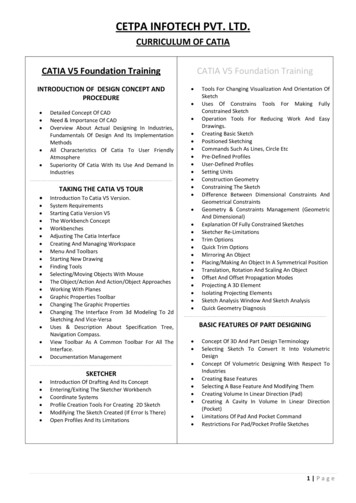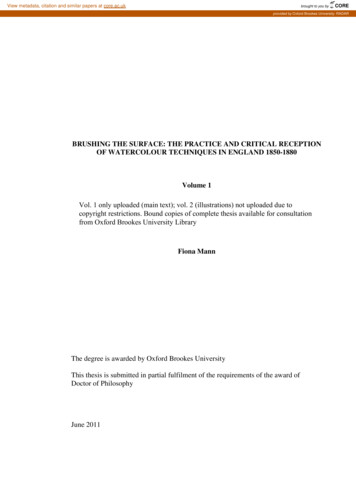
Transcription
View metadata, citation and similar papers at core.ac.ukbrought to you byCOREprovided by Oxford Brookes University: RADARBRUSHING THE SURFACE: THE PRACTICE AND CRITICAL RECEPTIONOF WATERCOLOUR TECHNIQUES IN ENGLAND 1850-1880Volume 1Vol. 1 only uploaded (main text); vol. 2 (illustrations) not uploaded due tocopyright restrictions. Bound copies of complete thesis available for consultationfrom Oxford Brookes University LibraryFiona MannThe degree is awarded by Oxford Brookes UniversityThis thesis is submitted in partial fulfilment of the requirements of the award ofDoctor of PhilosophyJune 2011
iiAbstractTwentieth-century art historical research has devoted little attention to the study ofwatercolour painting techniques and artists’ materials. This is especially true of theperiod following Turner’s death, when watercolour is said to have been in decline. Yetthe period 1850 to 1880 was a period of intense innovation and experimentation, whenwatercolour painting finally came to be accepted on an equal footing with its rival, themedium of oil. The expansion of annual exhibitions brought dazzling, highly finishedworks to the attention of the new middle-class buying public, who eagerly scanned thelatest press reviews for news and guidance.For the first time, I combine unpublished material from sources including nineteenthcentury colourmen’s archives, conservation records and artists’ descendants’collections, with an analysis of contemporary watercolour manuals and art criticalwriting in the press, to give a picture of the dramatic changes in technique whichoccurred at this time.Brilliant new pigments and improved artists’ papers and brushes flooded onto themarket via a growing network of artists’ colourmen. Affordable instruction manuals,aimed at the swelling ranks of amateur artists, were published, their successive editionshighlighting the changing character of watercolour practice, in particular the growinguse of bodycolour, microscopic detail and new tube pigments. Progressive artists suchas John Frederick Lewis, Samuel Palmer, Myles Birket Foster, John William Northand Edward Burne-Jones, developed revolutionary ways of incorporating the newartists’ materials into their watercolours, often to great commercial success. Exhibitionreviews by critics in the growing number of journals often commented loudly on thebright colouring, minute detail, texture and opaque effects produced by their use of thelatest pigments, papers and brushes.The impact made on watercolour painting by improved artists’ materials was farreaching, bringing power and status to a medium which had previously beenconsidered an inferior artform.
iiiContentsVOLUME 1AcknowledgementsList of illustrationsIntroductionPART ONEChapter 11.11.21.31.41.51.61.7Chapter 22.12.22.32.42.52.6PART TWOChapter 33.13.23.33.43.53.63.7Chapter 44.14.24.34.44.54.64.7Chapter 55.15.25.35.45.55.61214NEW ARTISTS’ MATERIALSDevelopments in Artists’ Materials 1850-1880Suppliers in London: the rise of the colourmenNew nineteenth-century pigments: ‘Fruits of the fecundity ofmodern chemistry.’‘Paper made by hand of every practicable size, quality ofsurface, and tint of colour’: new developments inpapermaking.From sable quill to ‘brights’ and ‘fans’: the watercolour brushMediums and fixativesPortable sketching equipmentConclusion‘Shilling vade-mecums:’ Watercolour manuals and thepromotion of new materialsThe impact of new pigmentsThe legitimacy of Chinese WhiteThe ‘Paper Question’Brushes: Quills or new metal ferrules?Crayons, fixatives and watercolour megilpConclusionWATERCOLOUR PRACTICE – FIVE CASE STUDIESJohn Frederick Lewis 1804-1876: ‘The Painter of greatestpower, next to Turner, in the English School’Lewis’s early years‘The subject, the manipulation, the peculiar colouring, werealike novel and singular’: Lewis’s Watercolours After 1850New pigments supplied by RobersonJapanned boxes, brushes and gum arabic from RobersonPaper supports used by LewisLewis’s use of Chinese WhiteConclusionSamuel Palmer 1805 – 1881The early watercolours: ‘timidity of execution’‘Sunbeams in a crucible’: the impact of new pigments onPalmer’s later watercoloursA late adoption of Chinese WhiteVehicles, gums, additives and crayonsPalmer’s brushesPalmer’s watercolour supports: an ‘intermediate betweenpaper and ivory’ConclusionMyles Birket Foster 1825-1899Three sources on Birket Foster’s pigmentsFoster and Chinese WhiteFoster’s choice of paper and board supportsBrushes, lay figures and gum arabicChromolithographs and 8130131132
ivChapter 66.16.26.36.46.56.66.7Chapter 4.27.4.37.57.5.17.5.27.5.37.6PART THREEChapter iographyJohn William North 1842-1924: ‘Painter and Poet’Beginnings as an illustratorNorth’s later techniqueNorth’s use of new pigmentsChinese WhiteNorth and the drive for a ‘practically imperishable’ paperBrushes and other materialsConclusionSir Edward Coley Burne-Jones 1833-1898Blurring the boundaries: ‘His drawings are literally intempera, and in substance and surface might almost bemistaken for oil’1857-1860Watercolours completedPigments purchased from RobersonSupports and other materials1861-1865Watercolours completedPigments purchased from RobersonSupports and other materials1866-1870Watercolours completedPigments purchased from RobersonSupports and other materials1871-1880Watercolours completedPigments purchased from RobersonSupports and other materialsConclusionCRITICAL RECEPTION‘All sorts of unnecessary and unpalatable impertinencies’:Critical responses to watercolour painting, methods andmaterials 1850-1880The criticsAnonymity: ‘an inflexible rule for journalists’Background, training and prejudicesCritical language and professionalism‘The agencies which endow great colourists with a power thatis absolutely without limit’: critical writing on new pigments‘Every variety of substance and surface, from the smoothnessof an ivory tablet to the roughness of a brick and plasterwall’: critical writing on new papersCritical writing on new fixatives, mediums, brushes andportable equipment‘It has, indeed, been rather revolution than evolution, and thewhole change may be ascribed to the use of opaque white’:critical writing on the use of bodycolour.‘More stitches than cloth’: critical writing on manipulationReviews of watercolour and drawing 31243
vAppendices IIIIIIIVVVIVIIVIIIIXXXIVOLUME 2Nineteenth-century definitions of termsDates of introduction of new nineteenth-century pigmentsColours listed in watercolour catalogues 1849-1879Roberson Archive – Materials bought by John FrederickLewis 1852-1875Palmer’s expanding use of pigments between 1830 and 1856Samuel Palmer’s recipe for Blake’s White, 1866Myles Birket Foster’s palette – three sourcesJ. W. North watercolours 1854-1880Year-by-year analysis of Burne-Jones’s purchases fromRoberson 1857-1880Art critics of periodicals and papers 1850-1880Some watercolour and drawing manuals reviewed by the ArtJournal, the Athenaeum and The GraphicIllustrations 1-191See pages 2-13 for a full listing and sources of the illustrations in vol. 2 of this thesis254261266270273274275276280293298
1AcknowledgementsOver six years, many people have given generously of their time and resources to helpme in my research. I would especially like to thank the following: John Foster andSteve Milton (descendants of Birket Foster and J.W. North) for generously allowingme access to unpublished family records, paintings and art materials; Anthony Oxleyof Laurence Oxley, Alresford; Jane Colbourne, Northumbria University; Carol Jacobi,Birkbeck College; Marie-Therese Maine and Ana Flyn, Laing Art Gallery, Newcastleupon-Tyne, and Piers Townshend, Tate Britain, for their advice on technical subjects;Tim Craven, Southampton City Art Gallery; Sarah Mulligan, Newcastle City Library,and Rebecca Watkin, Preston Museum and Art Gallery, for taking photographs for meof works in their collections; my second supervisor, Dr. Matthew Craske for hisguidance; Catherine Hilary, Curatorial Fellow at the Watts Gallery; Charles Noble,Chatsworth House, for allowing me private access to Palmer’s watercolours in theircollection; and the staff at the following institutions: Ashmolean Museum, Oxford;Birmingham Museum and Art Gallery; Bristol Museum and Art Gallery; BritishMuseum; Fitzwilliam Museum, Cambridge; Hamilton Kerr Institute, Cambridge;Museum of London; Tate Britain; Victoria and Albert Museum, London; Winsor &Newton, Harrow; and the Wingate Foundation and the Stapley Trust, for their muchvalued awards.Last, and by no means least, I owe an enormous debt to my supervisor, Dr. ChristianaPayne, for her unceasing patience and encouragement, and to my husband, Nic, andmy children, Harriet and Jason, for their love and unfailing belief in me.Abbreviations:HardieHardie, Martin, Water-colour Painting in Britain, 3 vols., London, 1966-68.HarleyHarley, R. D., Artists’ Pigments 1600-1835: a study in English documentarysources, 2nd revised ed., London, 2001.LettersRaymond Lister, (ed), The Letters of Samuel Palmer, 2 vols., Oxford, 1974.L&LA. H. Palmer, The Life and Letters of Samuel Palmer, London, 1892.ListerRaymond Lister, Catalogue Raisonné of the Works of Samuel Palmer,Cambridge, 1988.RogetRoget, John Lewis, History of the ‘Old Water-Colour Society’, vols. I and II,London, 1891.Ruskin, Works with the volume number:Ruskin, John, The Works of John Ruskin (Library Edition), ed. E.T. Cook andAlexander Wedderburn, 39 vols., London, 1903-12.SPWCSociety of Painters in Water-Colours (1804-), also known as the Old WaterColour Society from 1832 and as the Royal Society of Painters in WaterColours in 1881.
2List of IllustrationsFigure 1An Apothecary’s shop, shown in a fifteenth-century Italianmanuscript(Christopher de Hamel, Medieval Craftsmen: Scribes and Illuminators,London, 2002, p. 63)Figure 2Powdered pigments from ancient -times/)Figure 3Ackermann’s ‘Repository’ 101 Strand and Fuller’s ‘At the Temple ofFancy’, Rathbone Place, London.(R.D. Harley, Artists’ Pigmentsc.1600-1835, London, 2001, pp 186 and 177)Figure 4Figure 51850 Map of London, major artists’ colourmen’s locations.(Cross’s New Plan of London http://london1850.com/cross12.htm)The North London School of Drawing and Modelling, CamdenTown, Illustrated London News, 17th January 1852 (Stuart Macdonald,History and Philosophy of Art Education, 1970, facing page 81)Figure 6Embossed hard watercolour cakesFigure 7Moist watercolour cakes in pans(W&N 1863 catalogue; Reeves 1862 and 1879 catalogues)Winsor & Newton’s new Chinese White watercolour 1834(Don Pavey, The Artists’ Colourmen’s Story, London, 1984, p. 14).Figure 8(Winsor & Newton Catalogue of Materials for Water-Colour Painting, andSketching, Pencil, and Chalk Drawing, 1849, p. 14.)Figure 9Winsor & Newton’s new collapsible tube watercolours(top: D. Pavey, The Artists’ Colourmen’s Story, London, 1984, p. 19;middle: W&N Catalogue of Materials for Water-Colour Painting, andSketching, Pencil, and Chalk Drawing, 1849 p. 15 ; bottom: W&Ncatalogue 1878, attached to Henry Murray, The Art of Painting andDrawing in Coloured Crayons, London, 1878, p. 23)Figure 10Reeves& Sons’ octagonal cake watercoloursFigure 11Reeves & Sons’ Saucer of Moist Water ColourFigure 12Winsor & Newton’s watercolour preparation room and oil-tube fillingroom at the new North London Colour Works 1844Figure 13Reeves’ steam-powered colour works Dalston 1868(Reeves & Sons 1862 catalogue, p. 8)(Reeves & Sons 1862 catalogue, p. 8)(Don Pavey, The Artists’ Colourmen’s Story, London, 1984, p. 29)(Reeves & Sons, Price List for the Trade Only, London, 1873, facing titlepage.)Figure 14Burne-Jones watercolour, St Dorothea, c. 1866, 94.6 x 38.7 cm(37 ¼ x 15 ¼ in) (top), showing detail of efflorescence (below).Cartoon for stained glass for the east window of All Saints Church,Cambridge.Figure 15Making paper by hand c 1898(Photos: Piers Townshend, Conservation Department, Tate Britain, 2009)(Photograph: Bower Collection, published in Scott Wilcox, Sun, Wind andRain: the Art of David Cox, New Haven, 2008, p. 98)Figure 16Laid (left) and wove (right) papers(Harris and Wilcox, Papermaking and the Art of Watercolor in EighteenthCentury Britain: Paul Sandby and the Whatman Paper Mill, with essaysand contributions by Stephen Daniels, Michael Fuller, and Maureen Green,New Haven and London, 2006, p.79)
3Figure 17Three surfaces of white drawing paper: hot pressed (left), NOT(middle) and rough (right) These papers were made by BarchamGreen & Company Limited, Hayle Mill, Maidstone, Kent. The papershave the same composition and are of the same weight but are given adifferent finishing treatment.(Photograph: Collection of John Krill: published in Harris and Wilcox,Papermaking and the Art of Watercolor, p. 104)Figure 18Artists’ Drawing Papers sold by Winsor & Newton 1878(Winsor & Newton price catalogue, attached to Murray, Drawing inCrayons, London, 1878, pp. 36-37)Figure 19Flecked blue wove watercolour paper by Bally, Ellen & Steart. Sheetshowing Petworth Church from the River, by J.M.W. Turner, 1830,watercolour and bodycolour, 191 x 281 mm (7 ½ x 11 ins.), TurnerBequest, Tate Gallery. (Peter Bower, Turner’s Later Papers: A Study ofthe Manufacture, Selection and Use of his Drawing Papers 1820-1851,London, 1999, p. 67.)Figure 20Drying handmade paper over ropes ca. 1906(Photograph: Bower Collection, published in Scott Wilcox, Sun, Wind andRain: the Art of David Cox, New Haven, 2008, p. 98)Figure 21Drying paper flat on sails in racks ca. 1906 – ‘seamless paper’(Photograph: Bower Collection, published in Scott Wilcox, Sun, Wind andRain: the Art of David Cox, New Haven, 2008, p. 99)Figure 22An early papermaking machine possibly from the 1830s.Figure 23Winsor & Newton papers 1849(The Useful Arts and Manufactures of Great Britain (1840), London, p.3)(Catalogue of Materials for Water-Colour Painting, and Sketching, Pencil,and Chalk Drawing, London, pp. 19-20.)Figure 24Tails used in brush-making: (left to right) two varieties of squirrel,ermine, red sable.(Photograph: R.D. Harley, “Artists’ Brushes – Historical Evidence from theSixteenth to the Nineteenth Century”, International Institute forConservation Lisbon Congress 1972: Conservation of Paintings and theGraphic Arts, London , 1976, p. 127)Figure 25Sables in quills 1849(Winsor & Newton, Catalogue of Materials for Water-Colour Painting, andSketching, Pencil, and Chalk Drawing, &c, London, 1849, p. 21)Figure 26Red and Brown Sable Brushes 1849(Winsor & Newton, Catalogue of Materials for Water-Colour Painting, andSketching, Pencil, and Chalk Drawing, &c, London, 1849, p. 22)Figure 27New brush shapes – ‘brights’, ‘riggers’, ‘fan’ brushes and ‘extra finehog hair’ brushes, 1863(Winsor & Newton Catalogue – for Trade only, Brushes for Water and OilColour Painting, London, 1863, pp. 86-7.)Figure 28Foliage, glass painting and Harding’s Stiff Watercolour Brushes,1863(Winsor & Newton Catalogue – for Trade only, Brushes for Water and OilColour Painting, London, 1863, p. 75)Figure 29Winsor & Newton ‘Special’ hog hair brushes 1863(Winsor & Newton Catalogue – for Trade only, Brushes for Water and OilColour Painting, London,1863, pp. 88-89)Figure 30Figure 31Punch magazine’s portrayal of artists sketching outdoors with a rangeof portable equipment, 1865 (Punch, August 19, 1865, p. 72.)Winsor & Newton watercolour manual, c1900, 16th thousand editionof Charles William Day, The Art of Miniature Painting, firstpublished in 1852.
4Figure 32Figure 33Figure 34Figure 35Figure 36Figure 37Figure 38Figure 39Figure 40Figure 41Figure 42Figure 43Figure 44Figure 45Figure 46Figure 47The introduction of Aureolin,Winsor & Newton, Catalogue – forTrade only, Brushes for Water and Oil Colour Painting, London,1863, pp. 2-3.Watercolours in glass gallipots for Illumination and Missal Painting,Winsor & Newton catalogue, attached to Henry Murray,The Art of Painting and Drawing in Coloured Crayons, London,1878, p. 24.Illustration of hatching, cross-hatching and stippling, Sydney TrefusisWhiteford, A Guide to Figure Painting in Water-Colours, London,c.1878-80, facing page 24.Wide Flat Camel Hair Brushes, ½ inch to 4 ½ inches, Reeves andSons Price Catalogue, London, 1879, p. 58.John Frederick Lewis, The Hhareem, 1850, watercolour, 88.6 x 133cm (33 ¾ x 52 ½ in), Private Collection.Ghirlandaio The Birth of the Virgin, 1485-90, fresco, church of SantaMaria Novella, Florence.John Frederick Lewis, The Hhareem, c.1850, watercolour andbodycolour, 47 x 67.3 cm (18 ½ x 26 ½ in), Victoria and AlbertMuseum, London.John Frederick Lewis, The Noonday Halt, 1853, watercolour andbodycolour reinforced with gum arabic over traces of graphite onsmooth finished, very fine quality pure linen paper, mounted withfalse margins, 40.5 x 56.5 cm (15 7/8 x 22 ¼ in), Syndics of theFitzwilliam Museum, Cambridge.John Frederick Lewis, A Frank Encampment in the Desert of MountSinai. 1842 – The Convent of St. Catherine in the Distance, 1856,watercolour, gouache and graphite, 66.7 x 135.9 cm (26 ¼ x 53 ½ in),Yale Centre for British Art, Paul Mellon Collection. B1977.14.143John Frederick Lewis, An Arab Scribe – Cairo, 1852, pencil,watercolour and bodycolour and gum arabic on paper, 47 x 61 cm(18 ½ x 24 in), Private Collection.John Frederick Lewis, Hhareem Life, Constantinople, 1857,watercolour and bodycolour with gum arabic on conjoined pieces ofpaper, 62.2 x 47.6 cm (24 ½ x 18 ¾ in), Newcastle-upon-Tyne, LaingArt Gallery.John Frederick Lewis, The Siesta, c1876, watercolour overbodycolour reinforced with gum arabic over traces of graphite withwhite heightening on paper, the edges of which are folded round awooden panel, 46.5 x 59.1 cm (18 3/8 x 23 ¼ in), Syndics of theFitzwilliam Museum, Cambridge.John Frederick Lewis, The Siesta, 1876, OIL on canvas, 88.6 x 111.1cm (34 7/8 x 43 ¾ in), Tate Gallery.Anonymous artist, Official in a Green Robe, watercolour andbodycolour, c. 1809, 32.3 x 18.6 cm (12 ¾ x 7 ¼ in), Victoria andAlbert Museum, London, D.68- 1895. Commissioned by StratfordCanning (1786-1880). Artistic style is described as being in the‘dense and brilliant water and bodycolour used by Ottoman artists’.(http://collections.vam.ac.uk)John Frederick Lewis, Interior of a School, Cairo, 1865, watercolourand bodycolour on stiff paper, 47.1 x 60 cm (18 ½ x 23 5/8 in),Victoria and Albert Museum, London. (68-1890)John Frederick Lewis, Hhareem Life, Constantinople, detail
5Figure 48Figure 49Figure 50Figure 51Figure 52Figure 53Figure 54Figure 55Figure 56Figure 57Figure 58Figure 59Figure 60Figure 61Figure 62Figure 63John Frederick Lewis, Life in the Hhareem, Cairo, 1858, watercolourand bodycolour, 61.5 x 49 cm (24 ¼ x 19 ¼ in), Victoria and AlbertMuseum, London.John Frederick Lewis, Caged Doves, Cairo, 1864, watercolour andbodycolour, reinforced with gum arabic over traces of graphite onthin card, mounted with false margins, 32.6 x 22.7 cm (12 7/8 x 9 in),Syndics of the Fitzwilliam Museum, Cambridge.Japanned Palette Box. Reeves and Sons catalogue 1852, attached toReeves and Sons’ amateur’ and artists’ companion with an almanackfor 1852, London, 1852, p. 216.John Frederick Lewis, A Cairo Bazaar: the Della’l, 1875,watercolour heightened with bodycolour and gum arabic,67.5 x 51 cm (26 ½ x 20 in), Private Collection (Christies sale, 25November 2009, lot 14)John Frederick Lewis, Oriental Interior, 19th century, graphite,watercolour, bodycolour on paper (light buff), 25.3 x 37.3 cm(10 x 14 ¾ in), The Courtauld Gallery, London.John Frederick Lewis, details - A Cairo Bazaar: the Della’l (above)and Life in the Hhareem, Cairo (below), showing inscriptions.John Frederick Lewis, A Suliot warrior, indistinctly signed, inscribed'Suli[ot] JF Lewis' (lower right, partially overmounted), pencil andwatercolour with gum arabic heightened with touches of bodycolour,35 x 22.2 cm (13¾ x 8¾ in), Christies sale, 5 July 2011, lot 185.John Frederick Lewis, Interior of a School, Cairo, detail, showingwhite underpainting.John Frederick Lewis, The Pipe Bearer, 1859, pencil, watercolourand bodycolour on paper, 38.3 x 21.3 cm (15 x 8 3/8 in), CecilHiggins Art Gallery.John Frederick Lewis in oriental costumeUndated photograph, Private Collection.Samuel Palmer, Evening, 1821, brown ink and brown wash, 19 x 26.7cm (7 ½ x 10 ½ in), Victoria and Albert Museum, London.J M W Turner, Entrance of the Meuse: Orange-Merchant on the Bar,going to Pieces; Brill Church bearing S.E. by S., MasensluysE. by S., exhibited 1819, oil on canvas, 175.3 x 246.4 cm(69 x 97 in), Tate Gallery, London.Samuel Palmer, A Rustic Scene, 1825, brown ink and sepia mixedwith gum, 17.9 x 23.5 cm (7 1/8 x 9 3/8 in), Ashmolean Museum, Oxford.Samuel Palmer, Coming from Evening Church, 1830, mixed mediaon gesso on paper laid down on panel, 30.5 x 19.7 cm (12 x 7 ¾ in),Tate Gallery, London.Palmer’s expanding use of watercolour pigments between 1830 and1857, based on (L) Coming from Evening Church, 1830 (analysis inJoyce H. Townsend, William Blake: The Painter at Work, London,2003, p. 188) and (R) ‘Notes taken during the Lessons in WatercolorPainting from Samuel Palmer to Louisa Twining’, 1856, AshmoleanMuseum, Oxford, pp. 1-2.Samuel Palmer, Christian Descending into the Valley of Humiliation:Vide ‘Pilgrim’s Progress’, 1848, watercolour, gouache, black ink,black chalk and gold over faint squaring notations in graphite on offwhite lightweight artist’s board, 51.9 x 71.4 cm (20 3/8 x 28 1/8 in),Ashmolean Museum, Oxford.
6Figure 64Figure 65Figure 66Figure 67Figure 68Figure 69Figure 70Figure 71Figure 72Figure 73Figure 74Figure 75Figure 76Figure 77Figure 78Figure 79Samuel Palmer, Shady Quiet, 1852, watercolour, bodycolour and goldleaf, 18.7 x 41.2 cm (7 3/8 x 16 ¼ in), Royal Watercolour Soc. LondonSamuel Palmer, The Waters Murmuring, c1880, watercolour andbodycolour, 50.8 x 69.8 cm (20 x 27 ½ in), ING Bank N.V., LondonBranch.Samuel Palmer, A Chase in Venezia, 1861, watercolour over pencilwith gum arabic heightened with bodycolour on card, 19.5 x 43cm(7 ¾ x 16 7/8 in), Private Collection.Samuel Palmer, Western Shores, 1879, watercolour and bodycolour,with some pen and ink, on card, 12.7 x 18.9 cm (5 x 7 ½ in), Victoriaand Albert Museum, London.Samuel Palmer, The Bellman, 1881, watercolour and bodycolour onLondon board laid down on wood panel, 50.6 x 70.5 cm(19 7/8 x 27 ¾ in), Trustees of the Chatsworth Settlement.Samuel Palmer, The Eastern Gate, 1881, watercolour andbodycolour, on London board laid down on wood panel,49.5 x 70.5 cm (19 ½ x 27 ¾ in), Private Collection.Samuel Palmer, The Lonely Tower, 1868, watercolour andbodycolour with thick gum in places, 51 x 70.5 cm(20 1/16 x 27 ¾ in), Yale Center for British Art, Paul MellonCollection, New Haven.Samuel Palmer, A Towered City or The Haunted Stream, 1868,watercolour and bodycolour with gum on London Board,51.1 x 70.8 cm (20 1/8 x 27 7/8 in), Rijksmuseum, Amsterdam.Samuel Palmer, Tityrus Restored to his Patrimony, c.1874,watercolour and bodycolour with touches of gum arabic on card laiddown on paper, 50.2 x 69.9 cm (19 ¾ x 27 ½ in), BirminghamMuseums and Art Galleries.Samuel Palmer, The Prospect, 1881, watercolour and bodycolour onLondon board, 50 x 70.4 cm (19 ¾ x 27 ¾ in), Ashmolean Museum,Oxford.Samuel Palmer, Detail of The Prospect, showing the white primedground left in reserve (Image from W. Vaughan, Elizabeth E. Barker,Colin Harrison, Samuel Palmer: Vision and Landscape, (exh. cat.),London, 2005, p. 40.)Samuel Palmer, A Dream in the Apennine, 1864, watercolour,bodycolour and glue on four-ply laminate of white watercolour papers,with an initial priming of white, laid on wood 66 x 101.6 cm(26 x 40 in), Tate Gallery, London.Top: Samuel Palmer, The Waters Murmuring, c.1868, chalk and brownwash, heightened with white, on thick paper, 20.3 x 28.2 cm(8 x 11 in), Victoria and Albert Museum, London.Bottom: Samuel Palmer, The Eastern Gate, May 1879, black chalk,brown and white wash and white highlights, on buff card,19 x 26.7 cm (7 ½ x 10 ½ in), Victoria and Albert Museum, London.George Richmond – Sambo Palmer, 1825, pencil, 15.5 x 10.8 cm(6 x 4 ¼ in), Victoria and Albert Museum, London.Samuel Palmer, The Waters Murmuring, c1880 – detail.Samuel Palmer, The Sleeping Shepherd, c1854, watercolour,bodycolour, gum arabic, brown ink over graphite with scratching-outon off-white wove paper, laid down onto secondary support,24.5 x 17.8 cm (9 5/8 x 7 in), Fitzwilliam Museum, Cambridge.
7Figure 80Figure 81Figure 82Figure 83Figure 84Figure 85Figure 86Figure 87Figure 88Figure 89Figure 90Figure 91Figure 92Figure 93Figure 94Figure 95Figure 96Figure 97Samuel Palmer, A Chase in Venezia, 1861 – detail.Samuel Palmer, Tintagel Castle; approaching Rain, 1848-49,watercolour, gouache, graphite, black chalk and brown ink on buffwove paper, 30.2 x 44.2 cm (11 7/8 x 17 3/8 in), AshmoleanMuseum, Oxford.Samuel Palmer, Storm and Wreck on the Cornish Coast, c.1858,watercolour, bodycolour, brown wash and black chalk on grey paper,18.8 x 27.4 cm (7 3/8 x 10 ¾ in), Manchester City Galleries.Letter from Myles Birket Foster to Robert Spence,19 February 1860,p.2City Library, Newcastle-upon-Tyne, SL 920 756 (original image bySarah Mulligan, City Library).John Frederick Lewis’s The Hhareem hanging over the fireplace in‘The Hill’ at Witley, with four small Turner watercolours just abovePolly Brown’s head, from Jan Reynolds, Birket Foster, London,1984, p. 90.Birket Foster’s folding watercolour palette, Royal WatercolourSociety, London.Below: Figure - Detail of lumps of pigment on the palette.Winsor and Newton Japanned Tin Boxes of Moist Water Colours inPatent Collapsible Tubes, Winsor and Newton, Trade Catalogue,London, 1863, p. 27.Mahogany box of cake watercolours from Birket Foster, now in thecollection of John Foster, date c1852 to 1858.Newman’s Pricelist in the Birket Foster watercolour box now in thecollection of John Foster, c1852-1858.Reeves & Sons Mahogany watercolour box, 1862Reeves & Sons, 113 Cheapside, London, price catalogue, 1862, p.14.Birket Foster, At the Spring, c1863, watercolour and bodycolour,21 x 17cm (8 ¼ x 6 11/16 in), Private Collection (Bonhams sale,London, 29 September 2010 lot 131.)Birket Foster, The Little Shepherds, c1863, watercolour heightenedwith bodycolour, 22.5 x 25.6 cm (8 7/8 x 10 1/16 in), PrivateCollection, (Bonhams sale, London, 29 September 2010 lot 132.)Birket Foster, The Little Nurse, exhibited 1862?, watercolour overpencil with bodycolour & touches of gum, 13.3 x 18.6 cm(5 ¼ x 7 3/8 in), sold by Sotheby’s 22 November 2007, lot 183.Birket Foster, Young Gleaners Resting, c1862, watercolour andbodycolour, 30.2 x 45.4 cm (11 7/8 x 17 7/8 in), Victoria and AlbertMuseum, London.Birket Foster, The Chair-Mender, c1875, watercolour, 26 x 19.6 cm(10 ¼ x 7 ¾ in), Victoria and Albert Museum, London.Birket Foster, A Peep at the Hounds: Here they Come!, c1875,watercolour and bodycolour, 22.5 x 35.2 cm (8 7/8 x 13 7/8 in), fromJan Reynolds, Birket Foster, London, 1984, facing page 88.Birket Foster, A Lace-Maker, c1880-8, watercolour and bodycolour,46.4 x 41.3 cm (18 ¼ x 16 ¼ in), private collection, (sold byLaurence Oxley, Alresford).Birket Foster, Ben Nevis, 1891, bodycolour, pencil and watercolouron paper, 117.9 x 78.5 cm (46 3/8 x 30 7/8 in), Laing Art Gallery,Tyne & Wear Museums, Newcastle.
8Figure 98Figure 99Figure 100Figure 101Figure 102Figure 103Figure 104Figure 105Figure 106Figure 107Figure 108Figure 109Figure 110Figure 111Figure 112Figure 113Figure 114Drawing by Birket Foster onto nine boxwood engraving blocks,c1852, pencil, Chinese white and grey paint, 19 x 24.2 cm(7 ½ x 9 ½ in), City of Bristol Museum and Art Gallery.Birket Foster, A Cottage near Witley, Surrey, c1861, watercolour overpencil with bodycolour, 22 x 32 cm (8 ¾ x 12 ¾ in), Sotheby’s sale,London, 22 November 2007 lot 178, catalogue p. 82.Birket Foster, c1876, sketch showing bodycolour used to highlightareas and for correction, 13.5 x 17.8 cm (5 1/3 x 7 in), sketchbookP5-1922, Victoria and Albert Museum, London.Birket Foster, c1876, sketch showing bodycolour used for correction,13.5 x 17.8 cm (5 1/3 x 7 in), sketchbook P5-1922, Victoria andAlbert Museum, London.Birket Foster, Figures waiting on the shore at Hastings, c1864,signed with monogram and inscribed 'Hastings' (lower left), penciland watercolour, heightened with white, on buff paper, 29.3 x 55.6cm (11 ½ x 21 7/8 in), Christies Sale 5617, 30 June 2010, London.Birket Foster, c1876, sketch of The Donkey that would not go, pencil,ink/black paint and bodycolour, 13.5 x 17.8 cm(5 1/3 x 7 in), sketchbook P5-1922, Victoria and Albert Museum,London.Birket Foster, The Donkey that would not go, exhibited OWCS 1876,44.5 x 71.1 cm (17 ½ x 28 in), location unknown, illustrated inCundall, Birket Foster, London, 1906, p. 166.Birket Foster, The Harrow, c1860-1865, watercolour and bodycolour,35 x 85.8 cm (13 ¾ x 33 ¾ in), City of Bristol Museum and ArtGalleryBelow: Detail showing where the white paint has flaked off thebasket and white headscarf to expose the colour underneath.Birket Foster, The Little Nurse (detail).Birket Foster, Arrival of the Dover Packet, 12th May 1866, graphite,chalk, watercolour and bodycolour on blue paper, 17.2 x 8.6 cm(6 ¾ x 3 3/8 in), Fitzwilliam Museum, Cambridge.Birket Foster, Rottingdean, near Brighton, 1865, watercolour,34.3.x 71.7 cm (13 ½ x 28 ¼ in), Bury Museum and Art Gallery.Charles Keene, Birket Foster sketching, illustrated in H.M. Cundall,The Life and Work of Birket Foster, London, 1906, p. 162.Birket Foster, Fishing, exhibited 1862, watercolour over pencil withbodycolour and gum Arabic, 13.1 x 19 cm (5 3/8 x 7 ½ in),
of Laurence Oxley, Alresford; Jane Colbourne, Northumbria University; Carol Jacobi, Birkbeck College; Marie-Therese Maine and Ana Flyn, Laing Art Gallery, Newcastle-upon-Tyne, and Piers Townshend, Tate Britain, for their advice on technical subjects; Tim Craven, Southampton City Art Gallery; Sarah Mulligan, Newcastle City Library,


